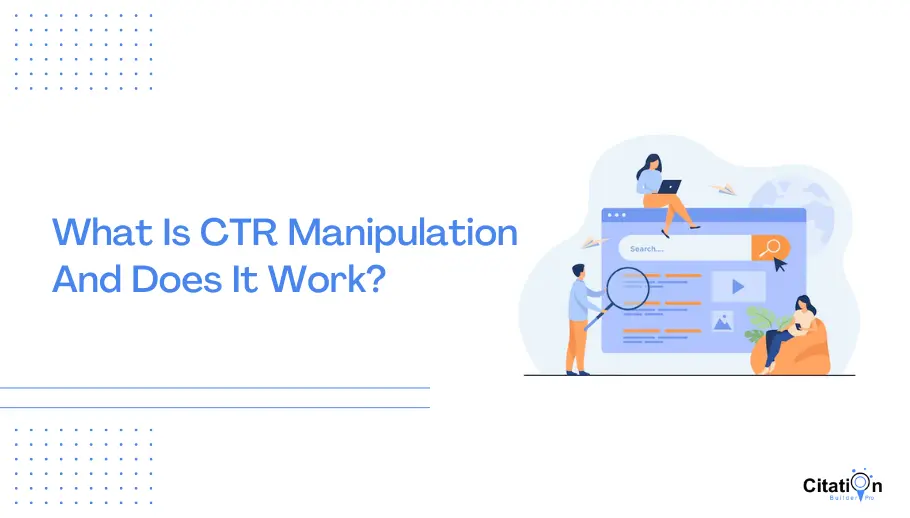Rise Neighborhood Presence with GMB CTR Manipulation Strategies
Boost Your Advertisement Efficiency With Smart CTR Adjustment
In the affordable landscape of electronic marketing, optimizing your click-through rate (CTR) is essential for improving total campaign efficiency. Strategic control of CTR can generate substantial enhancements, driven by customized content, involving visuals, and specific audience segmentation.
Comprehending Click-Through Price
Understanding Click-Through Rate (CTR) is crucial for evaluating the efficiency of electronic marketing techniques. CTR is a metric that shows the percentage of users that click on a specific link compared to the overall variety of individuals who watch the linked content, such as an ad or e-mail. It functions as a key efficiency indication (KPI) in internet marketing, reflecting the capacity of a project to involve its audience.
A high CTR frequently represents that the content is compelling and appropriate to the target group, while a reduced CTR might indicate the requirement for optimization. CTR Manipulation. Variables affecting CTR include advertisement placement, style, messaging, and audience targeting. Marketers should analyze these elements to boost efficiency and drive much better results
Furthermore, comprehending CTR allows businesses to make enlightened choices regarding their marketing strategies. By monitoring adjustments in CTR gradually, marketing professionals can identify trends, analyze the effect of various tactics, and allot resources effectively. Fundamentally, a detailed understanding of CTR is important for ongoing enhancement and success in digital advertising and marketing, supplying insights that lead the modification of campaigns to maximize interaction and conversion rates.

Relevance of CTR Manipulation
Adjusting Click-Through Rate (CTR) properly can considerably boost the performance of electronic marketing projects. A greater CTR suggests that a bigger proportion of individuals are involving with an ad, which is usually a reflection of its importance and appeal. This interaction not just boosts the visibility of the advertisement yet also signifies to online search engine and social networks systems that the content is important, possibly bring about better rankings and reduced costs-per-click.
Furthermore, a well-managed CTR can enhance spending plan allocation, making it possible for marketers to focus resources on the most efficient projects. This boosts roi (ROI) and can result in boosted conversions. In addition, understanding and manipulating CTR allows marketing professionals to get understandings right into audience behavior, preferences, and engagement patterns, promoting more educated decision-making.
In a competitive digital landscape, the value of CTR control can not be overemphasized. It functions as both an efficiency statistics and a critical device, encouraging marketers to refine their methods, tailor material, and eventually accomplish their advertising goals a lot more effectively. By prioritizing CTR, services can not just enhance their marketing outcomes but also grow more powerful links with their target market.
Secret Techniques for Enhancement
Exactly how can online marketers properly improve their Click-Through Rate (CTR)? One basic strategy entails maximizing ad duplicate.
Another effective strategy is to use audience division. By customizing ads to particular sectors based on demographics, passions, and behaviors, marketers can produce more appropriate web content, thus raising engagement and CTR. Customization can enhance individual experience and cultivate a connection with prospective consumers.
Additionally, integrating eye-catching visuals can improve advertisement appeal. Premium photos or videos that align with the message can attract focus and encourage individuals to click.
A/B screening is a critical practice also. By comparing different variations of advertisements, marketers can pinpoint which aspects drive greater CTR, making it possible for data-driven choices for future projects.
Lastly, guaranteeing mobile optimization is vital, offered the raising number of users accessing content through mobile phones. Advertisements have to be receptive and aesthetically enticing throughout all systems to optimize CTR properly. Implementing these strategies can lead to noticeable improvements in ad performance.
Tools for Tracking CTR
A selection of devices are readily available to properly track Click-Through Fees (CTR), making it possible for marketing experts to obtain valuable understandings right into their ad efficiency - CTR Manipulation. These devices can range from extensive analytics platforms to specific monitoring software program made visit site for specific ad formats
Google Analytics stands out as a durable choice, providing comprehensive reports on user communications, including CTR metrics. By integrating Google Tag Supervisor, marketers can conveniently track click particular ads while checking individual behavior throughout different channels.
Another noteworthy tool is SEMrush, which supplies competitive evaluation features along with CTR tracking, allowing marketing professionals to benchmark their performance against sector standards. Furthermore, systems like HubSpot offer built-in analytics for e-mail campaigns and landing pages, promoting direct dimension of CTR and conversion prices.
For social media sites advertising, tools such as Facebook Advertisements Supervisor and LinkedIn Campaign Manager offer real-time CTR information, making it possible for marketers to adjust their techniques instantaneously based upon efficiency outcomes.
Integrating these tools right into a general advertising and marketing approach not just aids in tracking CTR but also enhances decision-making processes, resulting in enhanced advertisement efficiency and raised ROI. CTR Manipulation.
Gauging Success and Readjusting

To measure success properly, it is necessary to establish benchmarks based upon historic data or industry criteria. These criteria provide a referral factor for evaluating current efficiency and determining locations for enhancement. Tools for tracking CTR, as reviewed formerly, play an essential role in this procedure, allowing marketing experts to gather information effectively.
Once efficiency metrics are collected, the following action involves assessing fads and patterns. If CTR is lower than anticipated, it may indicate the requirement for imaginative changes or audience improvement. Conversely, if conversion rates are high but CTR is reduced, focusing on boosting try this web-site exposure might be beneficial.

Conclusion
In verdict, efficient click-through rate (CTR) control considerably enhances ad efficiency via calculated optimization methods. Routine monitoring of CTR metrics using analytics devices promotes data-driven changes, making sure constant top article improvement and maximization of involvement.